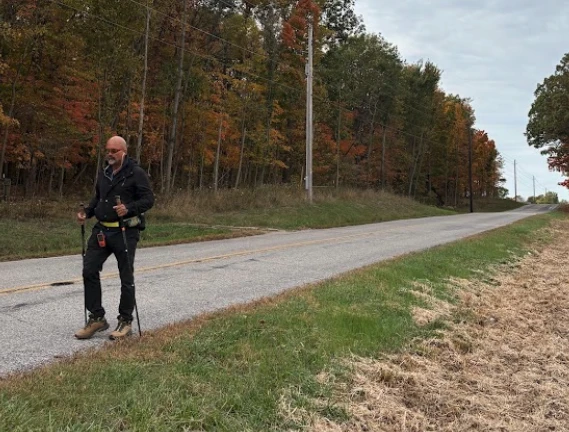

Father Gary Graf walks down a rural road during his trek across America in support of immigrants on Friday, Oct. 17, 2025. / Credit: Photo courtesy of Father Gary Graf
CNA Staff, Nov 24, 2025 / 06:00 am (CNA).
After a month and a half of walking an average of 17 miles a day, 67-year-old Father Gary Graf said he is starting to get “a little pain in one shin,” but his broken ribs are “getting much better.”
On Oct. 6, Graf, a Catholic priest from Chicago, began a journey on foot from Pope Leo XIV’s childhood home in Dolton, Illinois, to New York City to bring attention to the plight of immigrants amid the sometimes “inhumane” ways the Trump administration is treating them during its immigration enforcement actions.
He hopes to arrive at the Statue of Liberty on Ellis Island, where his own great-grandparents entered the country as immigrants, by Dec. 2.

A few weeks ago, when visiting a parish in Indiana, he was invited to ride a horse. He fell off as it galloped and broke several ribs, which led him to take one day off to recover. That day, friends walked in his stead.
Graf, the pastor of the mostly Hispanic Our Lady of the Heights Catholic Church in Chicago Heights and a longtime member of Priests for Justice for Immigrants, has committed his life to helping immigrants. Ordained in 1984, he spent five years as a priest in Mexico serving a people “with whom I fell deeply in love.”
He told CNA that after initially feeling helpless watching the raids taking place against his beloved community in his hometown of Chicago, he “felt a call that was directly from above” to start walking.

Within weeks, he was on the road. He first spoke to an old friend about his idea, who immediately connected him with Lauren Foley, the head of a public relations firm. She “immediately embraced the idea,” and between her help and that of some “young people who understand social media,” a website as well as social media accounts were set up to chronicle his journey and to share the stories of immigrant families.
Of the immigrants on whose behalf he is walking, Graf said: “I look to help people who get up every single morning to work and raise their families. If I can do this small gesture on their behalf, what a blessing it is, what a privilege.”
Asked about the most profound insight he has gained thus far, Graf said his long days walking through the wide expanse of rural America have helped him understand better the ways of people who did not grow up in a multicultural city like he did.
“We have to reverently appreciate and try to connect with those whose lives we’re passing through,” he said.
As he has spoken with people in diners along his path, Graf has developed “a greater sensitivity,” discovering that “there’s not a lot of animosity against the immigrant.”
Many of the people he has met simply do not know any, he said.
Along the way, he has also experienced unity with Christians from other denominations, as well as with those without religious faith, who all care about the humane treatment of human beings.
“I have seen so much goodness,” he said. “This has brought so many of us together: people from many different faith traditions, or none. This is an opportunity given to us.”
During his quiet walks through rural farmland, he has marveled at the amount of labor it took to build the many roads, bridges, and overpasses he has seen.
“I’m sure the hands of many immigrants helped build these things,” he reflected.
Graf said he is delighted that both the U.S. Conference of Catholic Bishops and Pope Leo XIV addressed the immigration enforcement situation in the past week.
The U.S. bishops issued a special message during its Fall Plenary Assembly two weeks ago, calling for “a meaningful reform of our nation’s immigration laws and procedures.” The bishops argued that “human dignity and national security are not in conflict. Both are possible if people of goodwill work together.”
The pope echoed the bishops’ message. On Nov. 18, he acknowledged to reporters that “every country has a right to determine who and how and when people enter.”
“But when people are living good lives, and many of them for 10, 15, 20 years, to treat them in a way that is extremely disrespectful, to say the least — and there’s been some violence, unfortunately — I think that the bishops have been very clear in what they said.”
“I think that I would just invite all people in the United States to listen to them,” the pope said.
“Both the pope and the bishops used the word ‘indiscriminate’ to talk about the way people are being singled out and aggressively having their wrists zip-tied behind their backs as their faces are pushed to the ground in front of their children,” Graf said.
“It is indeed indiscriminate. This reflects dishonesty on the administration’s part,” he said. “They said they were going after the ‘worst of the worst,’ criminals, but this isn’t the case, at least in Chicago. They’re grabbing people first and asking questions later.”
“The violent way many of these people are being treated is amoral and un-American,” he said.
Like the pope and the American bishops, Graf said he hopes the federal government will establish a more humane immigration system that respects the dignity of immigrants as well as the rule of law and the country’s right to regulate its borders.
“I am not a politician,” he said. “My job is to mediate, to speak up, in God’s name, in the united name of the Church. But can we look for a way for those who are fulfilling their responsibilities; for them to one day receive the rights of citizens?”
The priest, who appeared on “EWTN News Nightly” in October, said he has been “impressed by the media” and is grateful his message is being spread.
“If we don’t hear the whole truth, the incredible ignorance and darkness we live in can paralyze us, and keep us from doing what we ought to do,” he said.
Read More


















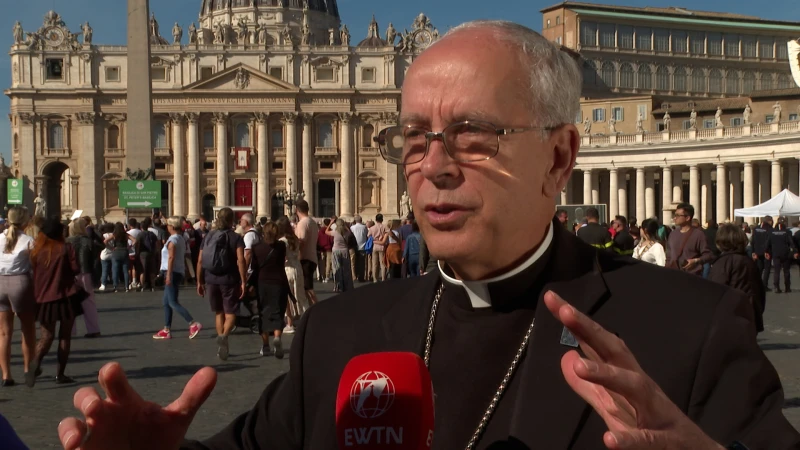



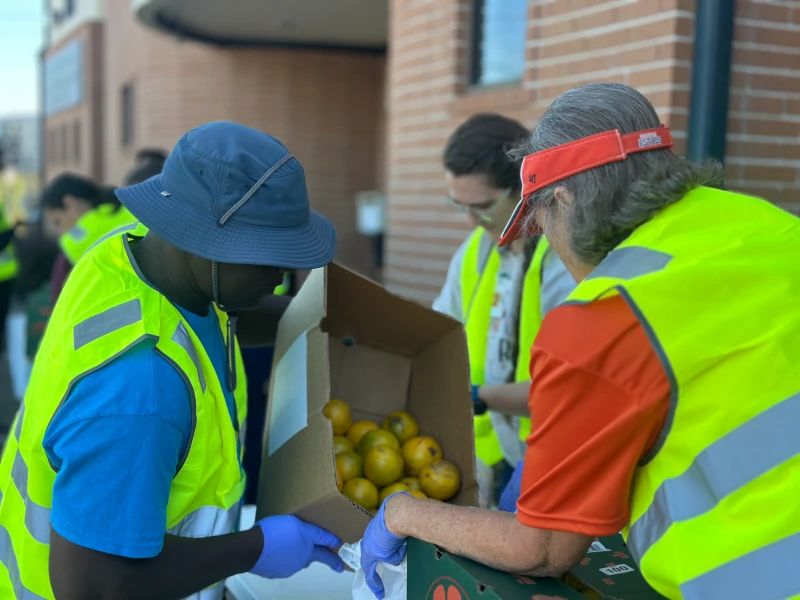


![Religious sisters announce historic land return to Wisconsin Native American tribe #Catholic
LaCrosse, Wisconsin. / Credit: JTTucker/Shutterstock
CNA Staff, Nov 7, 2025 / 06:00 am (CNA).
A Wisconsin religious community says it has completed the first known instance of a Catholic group returning land to a Native American tribe, hailing it as a move made in the “spirit of relationship and healing.”The Franciscan Sisters of Perpetual Adoration announced the transfer in an Oct. 31 news release on its website. The community is located in La Crosse, Wisconsin, near the state’s border with Minnesota.The sisters had purchased the land from the Lac du Flambeau Band of the Lake Superior Chippewa tribe in 1966 and used the property for its Marywood Franciscan Spirituality Center.The sisters said they sold the property to the tribe for $30,000, the exact amount for which they paid for the land six decades ago. The modern sale price represented “just over 1% of [the land’s] current market value,” the sisters said.The bargain sale represents “the first known return of Catholic-owned land to a tribal nation as an act of repair for colonization and residential boarding schools,” the sisters said.“Today, the tribe’s reservation represents only a fraction of [its] traditional territories,” the news release said. “Rebuilding and protecting tribal land bases is vital to sustaining sovereignty — it restores the ability for self-determination, cultural preservation, and community development.” “A strong land base supports essential services, creates employment opportunities, and provides a foundation for long-term economic and social resilience,” the sisters said. Tribal President John Johnson hailed the sale as “an example of what true healing and partnership can look like.” “We are proud to welcome Marywood home, to ensure it continues to serve future generations of the Lac du Flambeau people,” Johnson said. The sisters said the retreat center was “facing challenges to its viability,” leading the community to “discern a future for the land” in line with its institutional priorities. In their press release, the sisters said they have also been in “a process of reckoning” with the history of St. Mary’s Catholic Indian Boarding School. The sisters administered the school in Odanah, Wisconsin, from 1883 to 1969.Critics in recent years have claimed that such boarding schools participated in the erasure of Native American culture. Others have alleged that significant clergy sex abuse took place at such institutions.The sisters on Oct. 31 said such schools were guilty of “separating children from their families, suppressing Native identity, and paving the way for the large-scale seizure of Native homelands.”“It was painful to address our complicity, but we knew it had to be done,” former community president Sister Eileen McKenzie said in the press release.Diocese of Superior Bishop James Powers, meanwhile, praised the transfer, describing it as “a tangible act of justice and reconciliation that flows directly from the heart of our Catholic faith.”The Franciscan Sisters of Perpetual Adoration traces its roots to a group of Bavarian immigrants who traveled to Milwaukee in 1849 “intent upon founding a religious community to spread the Gospel among German immigrants.”The community has run hospitals and schools in Wisconsin and has also sponsored medical clinics and mission schools abroad.](https://unitedyam.com/wp-content/uploads/2025/11/religious-sisters-announce-historic-land-return-to-wisconsin-native-american-tribe-catholic-lacrosse-wisconsin-credit-jttucker-shutterstockcna-staff-nov-7-2025-0600-am-cna-a-wiscon.webp)



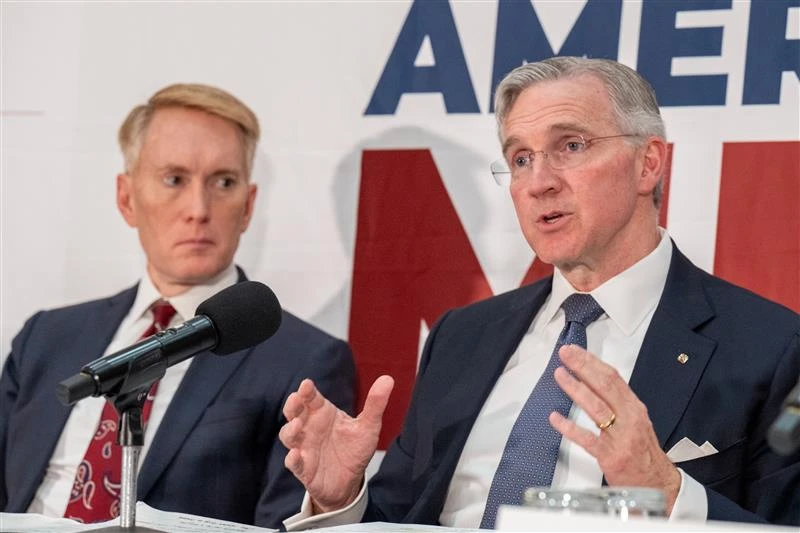



![Preparing for death with the Sister Servants of Mary #Catholic
The Sister Servants of Mary hold a procession with the statue of Our Lady of the Assumption at Mary Health of the Sick Convalescent Hospital in Newbury Park, California. / Credit: Photo courtesy of the Servants of Mary, Ministers to the Sick
CNA Staff, Nov 2, 2025 / 06:00 am (CNA).
When a 93-year-old Catholic father from New Orleans had a stroke, he knew he was prepared to die.Clinton Jacob attended adoration and Mass daily and was “rarely without a prayer book or rosary in hand,” according to his daughter, Kim DeSopo.“[He] never spoke of death with fear or sadness,” she told CNA. “He would simply say, ‘I’ll be going home.’”But not everyone feels prepared for death.The Servants of Mary, Ministers to the Sick, is a Catholic community of sisters who dedicate their lives to caring for the sick and dying in New Orleans and around the world. As nurses, they are at the bedside of the dying through the long nights, whether their patients are lifelong Catholics or have never thought about religion.The sisters often encounter patients as well as family members who are struggling to accept “an illness or imminent death,” Sister Catherine Bussen, a Servant of Mary, told CNA.“Many times, there is a need for reconciliation within the family, for a return to their faith, for acceptance of their condition, etc.,” Bussen said.As medical professionals, the sisters provide physical treatment, but they also walk with their patients throughout their illnesses, encouraging patients and families “always with the hope of eternal life,” Bussen said. DeSopo, Jacob’s daughter, called the sisters for support. The next day, Bussen arrived at their doorstep, and every night for two weeks, she sat at Jacob’s bedside. Bussen’s presence was “a gift,” DeSopo said. “Sister Catherine brought peace and calm into a time filled with stress and sorrow.”“Her prayers, patience, and care provided comfort not only to my father but also to my mother, who could finally sleep knowing someone trustworthy and compassionate was by his side,” DeSopo said, recalling Bussen’s “selfless dedication” and “unwavering faith.” Bussen was with Jacob when he died on Sept. 26, 2024. She prepared his body, cleaning him and sprinkling him with holy water, and then prayed with his wife and daughter.“I will never forget the care and dignity she gave him, even after his final breath,” DeSopo said.Sister Catherine (left) and Sister Dorian Salvador (right) pray for the soul of Kim DeSopa’s father on Oct. 1, 2024, at St. Clement of Rome Church in Metairie, Louisiana. Credit: Photo courtesy of Kim DeSopa and Sister CatherineMary at the foot of the cross “I was sick and you visited me.”This Scripture verse, Matthew 25:36, summarizes the charism of the Servants of Mary, according to Bussen. When they care for the sick, they care for Christ.The sisters will care for anyone in need, preferably within the sick person’s own home. In those who are suffering, the sisters “discover Jesus carrying his cross,” Bussen explained. “By caring for the sick, we believe that we are caring for Christ himself, who still suffers today in the suffering mystical body of Christ,” she said.Sister Angélica Ramos cares for Mrs. Hura, a resident of Mary Health of the Sick Convalescent Hospital in Newbury Park, California. Credit: Photo courtesy of the Servants of Mary, Ministers to the SickFounded in Madrid, Spain, in the 1800s, the sisters care for the sick and dying in Louisiana, Kansas, and California as well as throughout Central and South America, Spain, France, England, Italy, Cameroon, the Philippines, and Indonesia. They run a hospital for the poor in Bamenda, Cameroon, as well as two missionary houses in Oaxaca, Mexico.The sisters look to Mary as an example as they accompany those who are suffering.“Although we are not able to take away someone’s cross, we are present to them, offering all to the Father, like Mary did at the cross of Jesus, that all suffering may be redemptive and fruitful,” Bussen said.“Every one of us sisters would tell you that it is an absolute privilege to be able to enter into the intimacy of a family’s home, listening to the dying, praying with them, and encouraging them on the final stage of their journey as their soul passes into eternity,” she said.Sister Servants of Mary Fatima Muñoz and Carmela Sanz (front) celebrate a May crowning in Kansas City, Kansas. Credit: Photo courtesy of the Servants of Mary, Ministers to the Sick“Our Catholic Christian faith is a beautiful comfort during these times because it is all about looking forward to the promised life to come, the whole goal of our lives, eternal life,” Bussen said.One woman from New Orleans received news no one wants to hear — she had a terminal illness. Though she was not religious, she knew she needed help and did not know who else to turn to, so she called the Servants of Mary.As they cared for her and helped her deal with her terminal diagnosis, the sisters learned the woman was “completely alone in the world,” said Bussen, who took care of her. Other people from the surrounding Catholic community volunteered to stay with her.During that time, the woman found a home in the Catholic Church and received the sacrament of baptism.Her “anxiety was transformed into peace,” said Bussen, who was with her as she died.“As the end drew near, she had a new faith family,” Bussen said. “She was no longer alone.”Remembering the dead The life of a sister Servant of Mary is “contemplative in action.” The sisters unite “our prayer life with our work — going about what we are doing, in all the business of daily life, in a prayerful spirit,” Bussen said.The sisters have time set aside for prayer and work, “but these two aspects cannot be separated from one another,” she continued. “The grace and light received in prayer flows into our work and ministry, and everything we experience in our ministry is taken to prayer.”The Servants of Mary, Ministers to the Sick care for the sick and the dying. Credit: Photo courtesy of the Servants of Mary, Ministers to the SickThroughout the year, the sisters take special care to remember the dead. In November especially, Bussen said the sisters “remember all our patients who have died with us by placing their names in our chapel and offering Masses for their eternal happiness.”“Even after a patient has passed,” she said, “and they no longer need physical care, our ministry continues by praying for their soul.”](https://unitedyam.com/wp-content/uploads/2025/11/preparing-for-death-with-the-sister-servants-of-mary-catholic-the-sister-servants-of-mary-hold-a-procession-with-the-statue-of-our-lady-of-the-assumption-at-mary-health-of-the-sick-convalescent-h.webp)







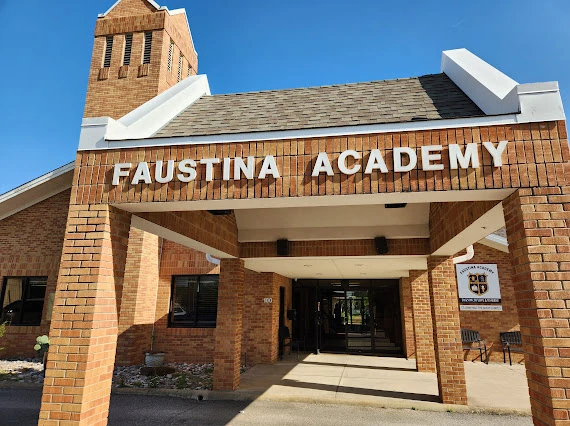




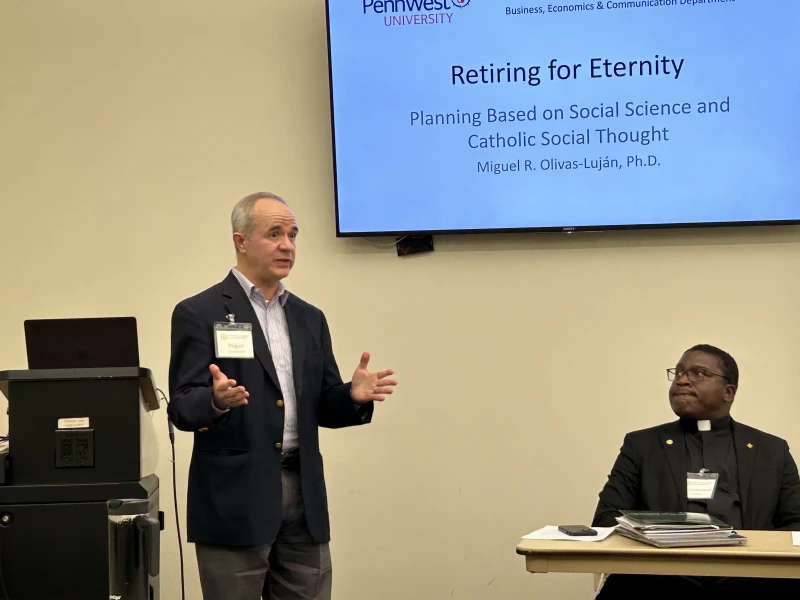


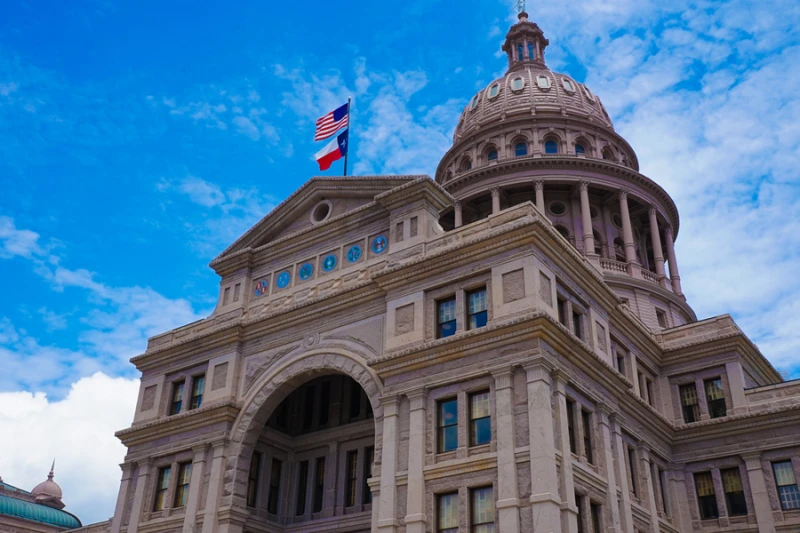



![‘Every execution should be stopped’: How U.S. bishops work to save prisoners on death row #Catholic
null / Credit: txking/Shutterstock
CNA Staff, Oct 25, 2025 / 06:00 am (CNA).
Bishops in multiple U.S. states are leading efforts to spare the lives of condemned prisoners facing execution — urging clemency in line with the Catholic Church’s relatively recent but unambiguous declaration that the death penalty is not permissible and should be abolished. Executions in the United States have been increasingly less common for years. Following the death penalty’s re-legalization by the U.S. Supreme Court in 1976, executions peaked in the country around the turn of the century before beginning a gradual decline.Still, more than 1,600 prisoners have been executed since the late 1970s. The largest number of those executions has been carried out in Texas, which has killed 596 prisoners over that time period.As with other states, the Catholic bishops of Texas regularly petition the state government to issue clemency to prisoners facing death. Jennifer Allmon, the executive director of the Texas Catholic Conference of Bishops, told CNA that the state’s bishops regularly urge officials to commute death penalty sentences to life in prison. “We refer to it as the Mercy Project,” she said. Though popular perception holds that the governor of a state is the ultimate arbiter of a condemned prisoner’s fate, Allmon said in Texas that’s not the case. “The state Board of Pardons and Paroles has the ultimate authority,” she said. “The governor is only allowed to issue a 30-day stay on an execution one time. He doesn’t actually have the power to grant a permanent clemency.” “We don’t encourage phone calls to the governor because it’s not going to be a meaningful order,” she pointed out. “The board has a lot more authority.”Allmon said the bishops advocate on behalf of every condemned prisoner in the state. “We send a letter to the Board of Pardons and Paroles and copy the governor for every single execution during the time period when the board is reviewing clemency applications,” she said. “Typically they hold reviews about 21 days before the execution. We time our letters to arrive shortly before that.” “We research every single case,” she said. “We speak to the defendant’s legal counsel for additional information. We personalize each letter to urge prayer for the victims and their families, we mention them by name, and we share any mitigating circumstances or reason in particular that the execution is unjust, while always acknowledging that every execution should be stopped.”Some offenders, Allmon said, want to be executed. “We do a letter anyway. We think it’s important that on principle we speak out for every execution.”In Missouri, meanwhile, the state’s Catholic bishops similarly advocate for every prisoner facing execution by the government. Missouri has been among the most prolific executors of condemned prisoners since 1976. More than half of the 102 people executed there over the last 50 years have been under Democratic governors; then-Gov. Mel Carnahan oversaw 38 state executions from 1993 to 2000 alone. Jamie Morris, the executive director of the Missouri Catholic Conference, told CNA that the state bishops “send a clemency request for every prisoner set to be executed, either through a letter from the Missouri Catholic Conference or through a joint letter of the bishops.”“We also highlight every upcoming execution through our MCC publications and encourage our network to contact the governor to ask for clemency,” he said. Individual dioceses, meanwhile, carry out education and outreach to inform the faithful of the Church’s teaching on the death penalty. What does the Church actually teach?The Vatican in 2018 revised its teaching on the death penalty, holding that though capital punishment was “long considered an appropriate response” to some crimes, evolving standards and more effective methods of imprisonment and detention mean the death penalty is now “inadmissible because it is an attack on the inviolability and dignity of the person.”The Church “works with determination for its abolition worldwide,” says the Catechism of the Catholic Church, the revision of which was approved by Pope Francis. The Church’s revision came after years of increasing opposition to the death penalty by popes in the modern era. Then-Pope John Paul II in 1997 revised the catechism to reflect what he acknowledged was a “growing tendency, both in the Church and in civil society, to demand that [the death penalty] be applied in a very limited way or even that it be abolished completely.”The Death Penalty Information Center says that 23 states and the District of Columbia have abolished capital punishment. Morris told CNA that bills to abolish the death penalty are filed “every year” in Missouri, though he said those measures have “not been heard in a legislative committee” during his time at the Catholic conference. Bishops have thus focused their legislative efforts on advocating against a provision in the Missouri code that allows a judge to sentence an individual to death when a jury cannot reach a unanimous decision on the death penalty. Brett Farley, who heads the Catholic Conference of Oklahoma, said the state’s bishops have been active in opposing capital punishment there after a six-year moratorium on the death penalty lapsed in 2021 and executions resumed. Oklahoma City Archbishop Paul Coakley and Tulsa Bishop David Konderla “have been very outspoken both in calling for clemency of death row inmates and, generally, calling for an end to the death penalty,” Farley said. The prelates have called for abolition via Catholic publications and in op-eds, he said.The state’s bishops through the Tulsa Diocese and Oklahoma City Archdiocese have also instituted programs in which clergy and laity both minister to the condemned and their families, Farley said. The state Catholic conference, meanwhile, has led the effort to pass a proposed legislative ban on the death penalty. That measure has moved out of committee in both chambers of the state Legislature, Farley said. “We have also commissioned recent polls that show overwhelming support for moratorium among Oklahoma voters, which demonstrate as many as 78% agreeing that ‘a pause’ on executions is appropriate to ensure we do not execute innocent people,” he said. Catholics across the United States have regularly led efforts to abolish the death penalty. The Washington, D.C.-based group Catholic Mobilizing Network, for instance, arose out of the U.S. bishops’ 2005 Catholic Campaign to End the Use of the Death Penalty. The group urges activists to take part in anti-death penalty campaigns in numerous states, including petitioning the federal government to end the death penalty, using a “three-tiered approach of education, advocacy, and prayer.”Catholics have also worked to end the death penalty at the federal level. Sixteen people have been executed by the federal government since 1976. Executions in the states have increased over the last few years, though they have not come near the highs of the late 1990s and early 2000s. Allmon said Texas is seeing “fewer executions in general” relative to earlier years. The number of executions was very high under Gov. Rick Perry, she said; the Republican governor ultimately witnessed the carrying out of 279 death sentences over his 15 years as governor. Since 2015, current Gov. Greg Abbott has presided over a comparatively smaller 78 executions. “It still shouldn’t happen,” she said, “but it’s a huge reduction.”](https://unitedyam.com/wp-content/uploads/2025/10/every-execution-should-be-stopped-how-u-s-bishops-work-to-save-prisoners-on-death-row-catholic-null-credit-txking-shutterstockcna-staff-oct-25-2025-0600-am-cna-bi.webp)

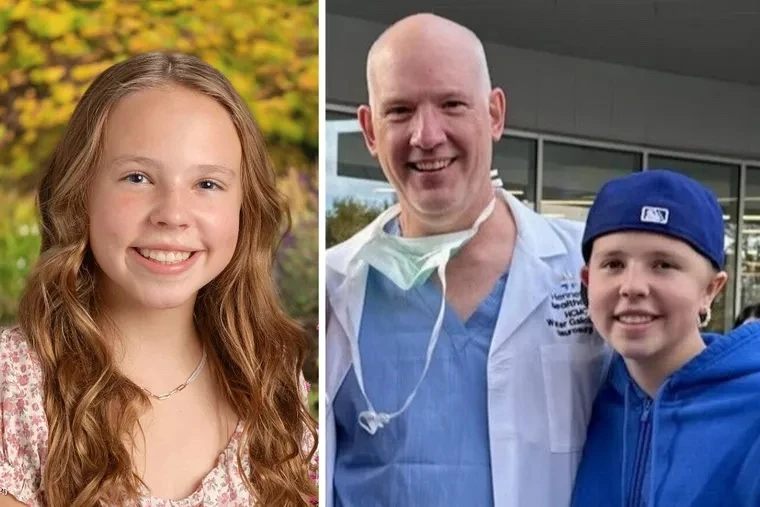



![Military archdiocese: Army’s response to canceled religious contracts ‘inadequate’ #Catholic
Archbishop Timothy Broglio speaks at Mass on Dec. 3, 2023. / Credit: The Basilica of the National Shrine of the Immaculate Conception
Washington, D.C. Newsroom, Oct 22, 2025 / 18:04 pm (CNA).
The Archdiocese for the Military Services, USA, expressed concern that the U.S. Army is not adequately addressing its discontent with canceled religious contracts, which the archdiocese said is straining its ability to minister to Catholics in the armed forces.This month, the Army canceled all contracts for three roles: coordinators of religious education (CRE), Catholic pastoral life coordinators (CPLC), and musicians. The contract terminations affected Catholics and those of other faiths.CREs served as catechists trained by the archdiocese to assist the priests in religious education in the military chapels. The archdiocese also trained CPLCs who offered administrative support such as liturgy coordination, assistance with sacramental record documentation, and weekly bulletin preparation. Contracts also included musicians, usually pianists who played music during Mass.Military Services Archbishop Timothy Broglio sent a letter to Congress on Oct. 17 saying Army officials assured him that religious affairs specialists (RAS) and directors of religious education (DREs) — federal employees — would accommodate the needs of the archdiocese amid the canceled contracts but that he believes this is not possible.Neither an RAS nor a DRE is a trained catechist, he explained, and neither are properly trained or qualified to perform the roles of people who served in the canceled contracts. There is no requirement for a DRE to be Catholic or for an RAS to have any faith.In response to the archdiocesan complaint, an Army spokesperson told CNA it would reexamine its contract support for RASs and DREs “to mitigate any potential impact during this period.“Archdiocese: Response is ‘wholly inadequate’Elizabeth A. Tomlin, a lawyer for the archdiocese, told CNA that the Army’s response is “wholly inadequate” and “demonstrates the spokesperson’s total lack of understanding of the issue.”“Merely eight DREs across the entire Army are Catholics, so most DREs are not qualified to direct Catholic religious education,” Tomlin said.“[RASs] are soldiers, [usually] anywhere from private first class to staff sergeant in rank,” she explained. “There is no requirement whatsoever for RASs to be Catholic or have any training in catechesis or catechetical methodology that could possibly equip them to coordinate religious education.”Tomlin rejected the Army’s assertion that people in these positions could fulfill the work of the CREs, CPLCs, or musicians.“Without meeting the basic requirement of a catechist, namely, to be a confirmed Catholic, these people are not qualified to be involved in Catholic religious education programs whatsoever,” she said.Tomlin said the only way to have music during Mass is if someone volunteers.“It is factually inaccurate that DREs or RASs are fulfilling the duties of CREs, CPLCs, or liturgical musicians,” Tomlin said.‘No knowledge of our faith’Jena Swanson — who worked as a Catholic CRE at Fort Drum from August 2024 until her contract was canceled on March 31, 2025 — told CNA she agrees with the archdiocese’s assessment that those employees cannot fulfill the roles of those whose contracts were canceled.She said she helped facilitate religious education classes, Bible studies, sacrament preparation classes, and retreats, and collected sacramental records, among a variety of other tasks. She said she mostly worked independently of the DRE because that employee did not have much knowledge about the Catholic faith.“The DRE is not guaranteed to be Catholic depending on the installation military families are stationed at,” Swanson said. “In our 13 years of military family life (my husband is active duty Army), we’ve experienced one Catholic DRE and only for two years.”She said in her experience, RASs “are as helpful as they can be” but often “have no knowledge of our faith.”Swanson said the Catholic community at Fort Drum “was thrown into a bit of chaos” once her contract ended. Some weeks there were no teachers for religious education, families did not know whom to direct questions to, and weekly Mass attendance dropped about 50%.“Our families want answers and want to continue coming to our parish, but if these options are not open it will drastically affect attendance and faith formation,” Swanson said.](https://unitedyam.com/wp-content/uploads/2025/10/military-archdiocese-armys-response-to-canceled-religious-contracts-inadequate-catholic-archbishop-timothy-broglio-speaks-at-mass-on-dec-3-2023-credit-the-basili.webp)









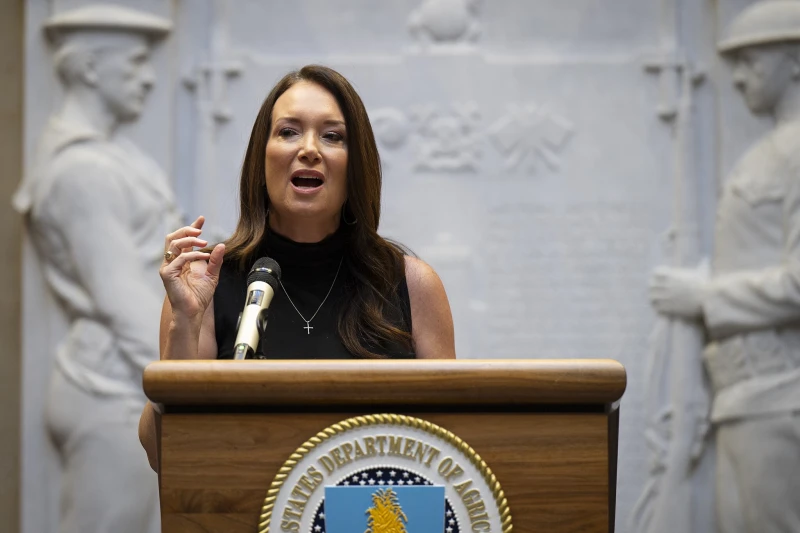

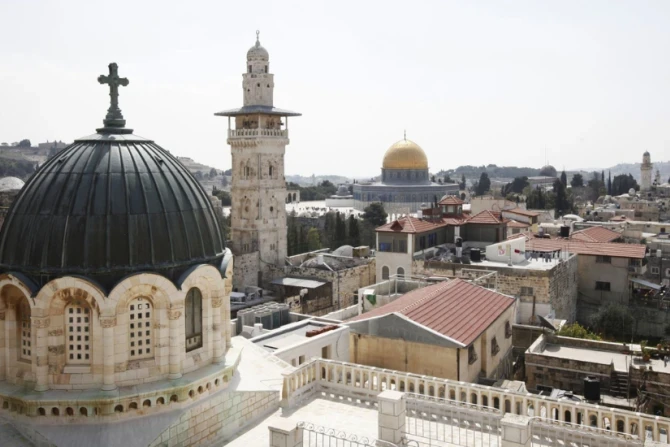



![Israelis, Gazan Christians, Catholics in U.S. weigh in on historic peace deal #Catholic
Daniel Ayalon, former Israeli ambassador to the U.S. and former foreign policy adviser to Prime Minister Benjamin Netanyahu, speaks with “EWTN News Nightly” anchor Veronica Dudo on Oct. 10, 2025. / Credit: “EWTN News Nightly”
Washington, D.C. Newsroom, Oct 11, 2025 / 08:00 am (CNA).
Former Israeli government officials, representatives for the Latin Patriarchate of Jerusalem, and Catholic advocates for Israel in the U.S. spoke with EWTN News this week following the historic peace deal brokered by the Trump administration between Israel and Hamas. News of the peace agreement came as “a joy for the entire population of Gaza, for the families of the hostages, and for our parish, our little parish there in Gaza,” according to Farid Jabran, the public and government affairs adviser for the Latin Patriarchate of Jerusalem.In an Oct. 10 interview with “EWTN News Nightly,” Jabran noted there is still an air of “expectation” as the region waits to “see what happens.”Jabran revealed that Latin Patriarch Cardinal Pierbattista Pizzaballa had spoken to the pastor of Gaza’s only Catholic Church, Father Gabriel Romanelli. “They are all very happy that they are not hearing more bombings,” Jabran said of the Gazan parish community. “They expect a better future, but still they wait to see what is going to happen … They’re all waiting to see what happens after the release of the hostages.” “The Catholic Church, as the patriarch, as the pope, as many said, will give anything in its power to to offer assistance, to offer good services when it’s asked to do so,” said Jabran, noting that the Latin Patriarchate has “big plans for Gaza,” including the construction of a new hospital in the southern region of the enclave. “We’ll have more details on that that will be supported by the Italian Conference of Catholic Bishops and the Latin Patriarchate,” he revealed, adding: “We are planning to create field hospitals in several places and to work on schools and education for the children, not only for the Christian community [but] for everyone.”Breaking down the peace deal In an Oct. 10 appearance on “EWTN News Nightly,” Daniel Ayalon, former Israeli ambassador to the U.S. and former foreign policy adviser to Prime Minister Benjamin Netanyahu, shared how the historic peace deal brokered by the Trump administration will play out in the coming days. Though both Israel and Hamas signed on to the first phase of the peace plan set out by the Trump administration on Wednesday, reports of ongoing bombardment from the IDF in northern Gaza was reported on Friday morning. Avalon explained that “there was a threat that the IDF depicted, and they had to take care of it.” “We have enough experience with Hamas that even though they agree on a ceasefire, they continue their aggression,” he told “EWTN News Nightly” anchor Veronica Dudo. “But we adhere, or Israel adheres to the agreement and to the ceasefire terms … We started right on time, and we are now back off the former position, and hopefully we will see our hostages within the next 72 hours.” President Donald Trump announced on Truth Social on Wednesday that both parties had agreed to the first phase of his 20-point peace plan for the Middle East, in which he noted: “ALL of the hostages will be released very soon, and Israel will withdraw their troops to an agreed-upon line as the first steps toward a strong, durable, and everlasting peace.”“I think that we should all acknowledge the leadership and the negotiation capabilities of President Trump and his team,” Ayalon said. “I believe that they found the right moment to really bring together an assembly of protagonists in the region that could really be instrumental, namely, Turkey, Qatar, and Egypt, that put a lot of pressure on Hamas that was not there before.” Given that the first phase goes according to plan, Ayalon said, Israel will release its Palestinian prisoners, and IDF troops will continue to withdraw, allowing Gazans to return to their homes. After which, he said, comes the precarious task of disarming Hamas, which will include dismantling its vast network of tunnels. This task, he predicted, could take several months. “I think the people of Gaza deserve this,” Ayalon reflected. “After these two horrendous years … they were actually held hostage by Hamas, which used them as cannon fodder or as human shields.” The former ambassador further expressed hope that Gazans ensure “no more terror organizations will grow there to a monstrous dimension, as we did with Hamas.”Looking ahead, Ayalon expressed hope for a broader normalization of relations between Israel and its Arab neighbors, such as Saudi Arabia and others, as well as other major Islamic countries such as Indonesia or Pakistan, to take place alongside reconstruction. He also floated the start of “a political process with the Palestinians,” noting Hamas will no longer govern the enclave. “It probably will be the Palestinian Authority,” he said, noting that under the agreement the governing body is mandated to promote peaceful coexistence and to “do away with terror” and indoctrination in its schools. “Then we can talk about real peace between Israel and the Palestinians, which may be a cornerstone of a much broader peace with the region,” he said, adding: “And we all deserve it — the world deserves it, and I think it will be to the benefit and the prosperity of all here.”Remembering Oct. 7On the two-year anniversary of the Oct. 7, 2023, Hamas attacks on Israel, Philos Catholic Director Simone Rizkallah told CNA: “This is not a day to discuss U.S. foreign policy or to analyze political dynamics.” Even with the Trump administration’s efforts in the background to make a peace deal between the Hamas terrorist group and Israel, Rizkallah emphasized, “Oct. 7 is a day to live out the beatitude ‘Blessed are they who mourn.’” Philos Catholic is an arm of the U.S-based nonprofit organization, the Philos Project, which works to foster Catholic-Jewish relations. Over 1,200 Israelis and 22 Americans were confirmed killed, and thousands more wounded in the wake of Hamas’ large-scale surprise attack on Israel. An additional 251 were taken hostage into the Gaza Strip.“We mourn with the Jewish people and with Israel as if we are mourning for our own selves — because, in truth, we are,” she said. “To stand with our Jewish brothers and sisters today is not a political act, and it is certainly not a partisan one. The Church is not a political entity. This is about faith and the culture that faith gives birth to.”According to Rizkhallah: “To speak up and stand with our Jewish friends is not sentimental — it is an act of spiritual realism and solidarity with our own people in the faith.” To do so, she continued, is not a partisan act but a “part of orthodox Catholic theology, rooted in the heart of the Church’s self-understanding.”Catholics, she urged, should “incarnate this love by showing up in the flesh” for their Jewish friends and neighbors. “Call your Jewish friends,” she said. “Reach out to your local synagogue or Jewish community center. Drop off white roses in the wake of antisemitic attacks — a symbol of Christian resistance to hatred, inspired by the White Rose movement that opposed Nazi Germany.”Philos Catholic will host an event commemorating the 60th anniversary of Nostra Aetate this year at the Saint John Paul II National Shrine in Washington, D.C., which will be available to attend both in person and virtually.](https://unitedyam.com/wp-content/uploads/2025/10/israelis-gazan-christians-catholics-in-u-s-weigh-in-on-historic-peace-deal-catholic-daniel-ayalon-former-israeli-ambassador-to-the-u-s-and-former-foreign-policy-adviser-to-prime-minister-ben.webp)
